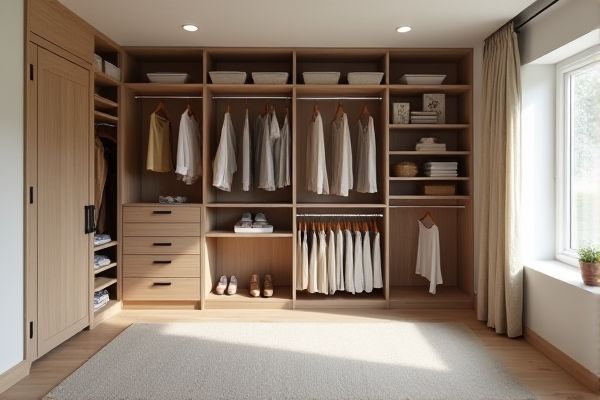
Built-in closets maximize space efficiency by being custom-fitted to your room's dimensions, offering a seamless, permanent storage solution that can increase home value. Explore the rest of the article to understand which option best suits your lifestyle and space requirements.
Table of Comparison
| Feature | Built-in Closet | Freestanding Closet |
|---|---|---|
| Customization | Highly customizable to fit space and design | Limited customization, fixed sizes and styles |
| Space Efficiency | Maximizes available space, often built to wall dimensions | Takes up additional floor space, less efficient |
| Installation | Permanent installation, requires professional fitting | Simple setup, usually portable and easy to assemble |
| Cost | Higher initial cost due to customization and installation | Lower upfront cost, more budget-friendly |
| Durability | Generally more durable and sturdy | Less durable, prone to wear and tear |
| Resale Value | Can increase home resale value | No impact on home resale value |
| Mobility | Fixed, cannot be moved | Portable, easy to relocate |
| Design Integration | Seamlessly blends with room architecture | Stands out as separate furniture |
Introduction to Built-in and Freestanding Closets
Built-in closets maximize space by being integrated directly into your room's architecture, offering a seamless design that enhances storage efficiency and room aesthetics. Freestanding closets provide flexibility, allowing you to move or replace them easily while offering a variety of styles to suit your decor preferences. Choosing between the two depends on your space constraints, design goals, and need for mobility.
Key Differences Between Built-in and Freestanding Closets
Built-in closets are custom-designed to fit seamlessly into your room's architecture, maximizing space with permanent fixtures, while freestanding closets offer flexibility and mobility with standalone units. Built-in options typically provide more storage efficiency and a sleek, integrated look, whereas freestanding closets allow for easier rearrangement and style changes. Your choice depends on whether you prioritize space optimization or adaptability in your home organization.
Pros and Cons of Built-in Closets
Built-in closets offer a seamless, space-saving design that maximizes storage while blending with your room's architecture, creating a custom look tailored to your needs. However, they require professional installation, are less flexible for relocation, and may involve higher upfront costs compared to freestanding closets. Your choice depends on the balance between long-term investment and the convenience of movable storage solutions.
Advantages and Disadvantages of Freestanding Closets
Freestanding closets offer flexibility and ease of installation, making them ideal for renters or those who frequently rearrange their space. They are typically more affordable and come in various styles and sizes, but they may lack the personalized fit and permanent storage efficiency of built-in closets. While providing convenience, freestanding closets can occupy more floor space and may not maximize room aesthetics as seamlessly as custom-built solutions.
Space Utilization: Which Closet Maximizes Storage?
Built-in closets maximize storage by utilizing wall space from floor to ceiling, often incorporating customized shelves, drawers, and compartments tailored to your room's dimensions. Freestanding closets offer flexibility and portability but typically consume more floor space and provide less overall storage capacity compared to built-in options. Choosing a built-in closet optimizes space utilization, making it ideal for maximizing storage in smaller or uniquely shaped rooms.
Customization Options: Built-in vs Freestanding Closets
Built-in closets offer extensive customization options tailored to maximize space efficiency, allowing for bespoke shelving, drawers, and compartments that fit perfectly within specific room dimensions. Freestanding closets provide flexible, modular solutions that can be easily relocated or reconfigured but often lack the precise, space-optimized features of built-in systems. Customization in built-in closets includes choices in materials, finishes, and hardware to seamlessly integrate with room decor, whereas freestanding models prioritize portability and simpler assembly.
Cost Comparison: Built-in Closet vs Freestanding Closet
Built-in closets generally require a higher initial investment due to custom design, materials, and professional installation, but they add significant value and durability to your home. Freestanding closets are more budget-friendly and offer flexible placement options, but may lack the seamless integration and long-term sturdiness of built-ins. Evaluating your space and budget helps you decide whether the upfront cost of a built-in closet outweighs the affordability and convenience of a freestanding option.
Installation and Maintenance Considerations
Built-in closets require professional installation, often involving carpentry and precise measurements to fit seamlessly into your space, resulting in a more permanent and tailored storage solution. Maintenance for built-in closets is minimal but can be more challenging if repairs or modifications are needed, as they are integrated into your walls or structure. Freestanding closets offer easier installation with no structural changes needed and provide flexibility to move or replace them, but they may require regular upkeep like tightening screws and dusting to maintain stability and appearance.
Design Flexibility and Home Resale Value
Built-in closets offer superior design flexibility by seamlessly integrating with a room's architecture, allowing for customized storage solutions that maximize space efficiency and aesthetic appeal. They enhance home resale value by providing a polished, permanent storage option that appeals to potential buyers seeking tailored, high-quality features. In contrast, freestanding closets offer mobility and ease of replacement but typically lack the cohesive, space-optimizing design that built-in closets provide, which can limit their impact on overall home value.
Choosing the Right Closet for Your Needs
Built-in closets maximize space with custom designs that fit your room's dimensions perfectly, offering a seamless and permanent storage solution ideal for long-term use. Freestanding closets provide versatility and mobility, allowing you to rearrange or relocate your storage without commitment to a specific room layout. Assess your space, lifestyle, and future plans to choose the closet that best enhances your organization and complements your home.
 homyna.com
homyna.com